Surface Pressures in Lower Extremity Splints: A Biomechanical Study
- PMID: 36937805
- PMCID: PMC10014985
- DOI: 10.1177/24730114231160115
Surface Pressures in Lower Extremity Splints: A Biomechanical Study
Abstract
Background: Though ubiquitously used in orthopaedic trauma, lower extremity splints may have associated iatrogenic risk of morbidity. Although clinicians pad bony prominences to minimize skin pressure, the effect of joint position on skin pressure and, more specifically, changing joint position, is understudied. The purpose of this biomechanical study is to determine the effect of various short-leg splint application techniques on anterior ankle surface pressure in the development of iatrogenic skin pressure ulcers.
Methods: Various constructs of lower extremity, short-leg splints were applied to 3 healthy subjects (6 limbs total) with an underlying pressure transducer (Tekscan I-Scan system) on the skin surface centered on the tibialis anterior tendon at the level of the ankle. All subjects underwent anterior ankle surface pressure assessment when padding was applied in maximum plantar flexion and neutral position for conventional short-leg splints application in clinically relevant patient scenarios. Percentage change from initial contact pressure centered on the tibialis anterior with cast padding were calculated.
Results: The percentage change in anterior ankle contact pressure when padding was applied in maximum plantar flexion (PF) and then definitively placed in neutral was increased at least 2-fold without the addition of plaster in lower extremity short-leg splints. Removing anterior ankle padding following final splint application in neutral reduced contact forces at the anterior ankle 46% and 59% in splints applied in maximum PF and neutral ankle position, respectively.
Conclusion: The present study is the first of its kind to underscore and quantify clinically relevant technical pearls that can be useful in reducing risk of iatrogenic risk of skin breakdown at the anterior ankle when placing short-leg splints, mainly, that it is imperative to apply padding in the intended final splint position and to remove anterior ankle padding following splint application when able.
Level of evidence: Level IV, biomechanical study with clear hypothesis.
Keywords: iatrogenic injury; immobilization; patient safety; pressure wounds; splints; trauma.
© The Author(s) 2023.
Conflict of interest statement
The author(s) declared no potential conflicts of interest with respect to the research, authorship, and/or publication of this article. ICMJE forms for all authors are available online.
Figures




References
-
- Barry K, Hoopes RR, Thrush J, Huff S, Albert M. A retrospective study to identify factors contributing to pressure ulcers in pediatric patients with lower extremity splints. Biomed J Sci Tech Res. 2020;30(3): 23430-23434. doi:10.26717/BJSTR.2020.30.004957 - DOI
LinkOut - more resources
Full Text Sources
Research Materials
Miscellaneous
